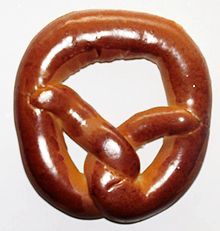Kringle
 Kringle | |
| Type | Pastry |
|---|---|
| Region or state | Scandinavia |
Kringle (/ˈkrɪŋɡəl/, ![]() listen (help·info)) is a Northern European pastry, a variety of pretzel. Pretzels were introduced by Roman Catholic monks in the 13th century in Denmark, and from there they spread throughout Scandinavia and evolved into several kinds of sweet, salty or filled pastries, all in the shape of kringle.
listen (help·info)) is a Northern European pastry, a variety of pretzel. Pretzels were introduced by Roman Catholic monks in the 13th century in Denmark, and from there they spread throughout Scandinavia and evolved into several kinds of sweet, salty or filled pastries, all in the shape of kringle.
In Danish and Norwegian, the word is kringle, plural kringler; Estonian: kringel, plural kringlid; Latvian: kliņģeris, plural kliņģeri; Swedish: kringla, plural kringlor; Finnish: rinkeli; German: Kringel and Icelandic: kringla. The word originates from the Old Norse kringla, meaning ring or circle.

In the Netherlands, a particular type of sweet kringle is well known under the Dutch name krakeling.
The shape of the kringle has given name to a similarly entangled feature found in some proteins, the so-called Kringle domain.
[]
This section needs expansion with: information about Kringle in Norway and Sweden (and Finland?). You can help by . (March 2016) |
In Denmark, kringle denotes the pretzel-like knotted shape rather than the pretzel pastry type. Kringler may be made from puff pastry (like Danish pastry) or yeast dough, filled with remonce or marzipan and raisins, sprinkled with coarse sugar, nut flakes or icing.
Other types of kringle in Scandinavia includes saltkringler, which are small salty kringler - the Scandinavian equivalent of pretzels -, and kommenskringler which are half-hand-sized breads in the kringle shape, made from unsweetened yeast dough spiced with caraway seeds. Sukkerkringler are similar, but sweet pretzels, sprinkled with sugar instead of caraway. Fødselsdagskringler are a large sweet bread pretzel for birthday celebrations.[1] Smørkringler are large crusty and sweet pretzels with a spread of butter on the backside. Smørkringler are not as popular nowadays.[2][3]
Kringler are pastries with a long history in Denmark, and are still popular items in modern Danish bakeries. Nowadays, kringle is usually made with only one crossing and not two, as in the original kringle and pretzel shape.[4]
United States[]

In the United States, kringles are hand-rolled from Danish pastry dough (wienerbrød dough) that has been rested overnight before shaping, filling, and baking. Many sheets of the flaky dough are layered, then shaped into an oval. After filling with fruit, nut, or other flavor combinations, the pastry is baked and iced.[5]
Racine, Wisconsin has historically been a center of Danish-American culture and kringle making. A typical Racine–made kringle is a large flat oval measuring approximately 14 inches by 10 inches and weighing about 1.5 pounds.[5] The kringle became the official state pastry of Wisconsin on June 30, 2013.[6] A Wisconsin distillery, in Middleton, Wisconsin, makes a kringle cream liqueur from Wisconsin cream, rum, sugar, and natural kringle flavor.[7]
In other parts of the United States, kringle may refer to a slightly sweet buttermilk cookie shaped like a pretzel or figure eight.[8]
Other places where kringles may be found in the United States include the Ballard area of Seattle, Washington; Redmond, Washington; Solvang, California; central Iowa, specifically Story City, IA; Burr Ridge, Illinois; Springfield, Missouri and Watertown, Massachusetts. In 2005, Dana College in Blair, Nebraska, held a Kringle Kontest, which was won by Kirsten's Danish Bakery in Burr Ridge, Illinois.
Symbolism[]

Baker's guilds in Europe have used the kringle or pretzel as a symbol for centuries. It is told (but currently unconfirmed by historic documents), that when Vienna was besieged by the Turkish Ottoman armies in 1529, local bakers working in the night gave the city defence an early warning of the attacking enemy. For this, they were later rewarded by the Pope, with permission to use a crown as part of their kringle guild symbol.
For unknown reasons, the guild in Denmark is now the only baker's guild in the world with official authority to display a royal crown as part of their baker's guild trade symbol that is often hung outside of bakery shops.[4][9]
See also[]
- Danish cuisine
- Estonian cuisine
- King cake
- Norwegian cuisine
 Food portal
Food portal
References[]
- ^ "Fødselsdagskringle - Birthday Kringle - Sons of Norway".
- ^ "Finurligheder [Curiosities]" (in Danish). Københavns Bagerlaug. Retrieved 24 April 2015. Official homepage of the Baker's Guild of Copenhagen.
- ^ Frithjof Smith-Hald (1887). "Pike med vogn og smørkringle" (in Norwegian). Nasjonalmuseet. Retrieved 31 May 2017.
- ^ Jump up to: a b "The history of Copenhagens Baker's Guild" (in Danish). Københavns Bagerlaug. Retrieved 24 April 2015. Official homepage of the Baker's Guild of Copenhagen.
- ^ Jump up to: a b Marialisa Calta. "Fare of the country: Wisconsin, Danish Pastry With a Classic Twist". The New York Times, July 9, 1989.
- ^ "Kringle becomes Wisconsin state pastry". WTMJ, July 1, 2013. Accessed July 26, 2013.
- ^ "GSN Review: Kringle Cream" December 29, 2013.
- ^ Dedman, Sherry. "Kringla Danish Kringle Recipe". Old Recipe Blog. Archived from the original on 27 November 2013. Retrieved 17 February 2013.
- ^ "Med krone på [wearing a crown]" (in Danish). Bager og Konditormestre i Danmark. Retrieved 24 April 2015. Official homepage of the association of Bakers and Confectioners in Denmark.
External links[]
| Wikimedia Commons has media related to Kringle. |
- Danish pastries
- Estonian cuisine
- Norwegian cuisine
- Cuisine of Wisconsin
- Cuisine of the Midwestern United States
- Pretzels
